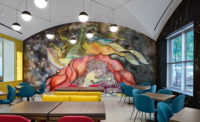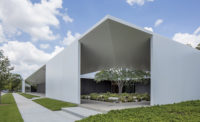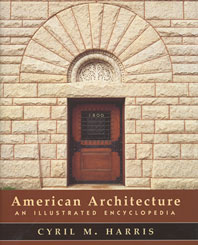In the mid-1980s, UCLA moved its graduate art studios six miles off campus to a former wallpaper factory in a then-industrial section of Culver City. The university purchased the boxy concrete warehouse as an economical solution to the department’s spatial needs; whether the intent was also to encourage an independent spirit in the graduate arts programs, it did just that. The corner building—completed in 1948, with classic, wood bowstring trusses overhead—was raw and durable, and the students energetically, often without restraint, coopted it. Over the years, the structure’s generous street setbacks, to its south and on its west side (where trucks originally pulled up to the loading docks), acquired clusters of small sheds, including a lean-to jerry-rigged as a woodshop and shipping containers that served as spray booths. “To say the place was adapted ad hoc,” says UCLA principal project manager John D’Amico, “is to put it nicely.” It was a messy, creative complex, without such updates as modern climate control or real accessibility. By 2010, when the university issued an RFP, an inspired overhaul was in order. The resulting project—which more than doubles the original 21,100-square-foot factory— finally reached completion this fall.
Additional Content:
Jump to credits & specifications
The scheme, by Los Angeles architects Johnston Marklee (JML), envisioned wrapping the building with an L-shaped addition, replacing the motley shacks (as well as modest industrial-era add-ons). But after JML’s feasibility study, in 2011, the project idled, awaiting funding. That came in 2016 with a $20 million lead gift from retired gallerist Margo Leavin, a UCLA alumna and legendary figure on Los Angeles’s art scene. Known for her eponymous gallery, active from 1970 to 2013, she embraced the opportunity to support education for future artists. “This top-rated art school was—regarding its facility—like an orphan to the university,” Leavin recalls. “It needed pride of place and a real boost. Immediately, I knew this was the project for me.”
In practical terms, the 47,900-square-foot renovation- expansion had to eliminate the main floor’s multiple level changes and update the fire protection, as well as the seismic and sustainability infrastructure. But a key conceptual question, says JML principal Sharon Johnston, “was how to create a state-of-the-art MFA facility without erasing the original spirit and culture.” The concrete building’s almost indestructible nature had clearly inspired improvisational uses—as had a defunct, wildly overgrown rail spur, along the site’s northern edge, that students had unofficially appropriated. (By 2016, the city had paved over the spur for parking, but its history still resonated with the school’s indoor-outdoor life.)
With interpretive twists, JML’s design drew on the existing building’s DNA and the original industrial character of the surrounding Hayden Tract (now a rapidly gentrifying neighborhood, with tech start-ups occupying former manufacturing plants, as well as sculptural follies and larger works by architect Eric Owen Moss punctuating the area). Though the 1948 factory was poured concrete, says Johnston, “we wanted to harken back to the tilt-up vernacular, found here and elsewhere in LA.” But JML modified the technique by casting in a vertical texture of “pillows,” or rounded pilasters, lending the elevations scale and detail.
Abstractly, the design nods to classical forms, articulating this “colonnade” with a simplified plinth below and entablature-like cap above. The architects also achieved a virtually seamless exterior rhythm, with no visible distinction between the unsheathed frame and infill, by giving the exposed poured-in-place columns (to which the cast elements tie) “pillow” contours matching the tilt-up panels. The result is a continuous surface of inverse flutes, animated by light and shadow.
The approach was economical (within the $23.2 million construction budget) and sustainable (reducing heavy-materials transport in a project poised for LEED Gold certification). It was also time-effective, meeting the inflexible first-day-of-school opening date of September 30. But tight site conditions and such obstacles as power lines made the method challenging.
To envelop the arts “campus” within this shell, the architects used large, windowless expanses of wall, typical of warehouses. But they also cut out sections—as for the building’s new entry garden, at its northwest corner—veiling them in a fine-grained chain link that balances competing needs for privacy and neighborhood connections. The structure now integrates three semi-outdoor zones: besides the entry/hangout/barbeque area, planted with trees and wall-climbing vines, there’s also a sculpture-work yard and one, with loading docks, for ceramics.
While the project retained (but, in some cases, reconfigured and/or relocated) such programmatic elements as a woodshop, the “center bay” crit area, and 42 individual studios, it added an exhibition gallery, garden-side kitchen, video-shooting room, and, on the new upper level (made possible by the soaring height of the expansion), an artist-in-residence loft, a classroom, and labs.
Tying it all together—and introducing much-needed daylight—is a luminous landscape overhead. There the architects restored the existing bowstring trusses, adding seismic bracing and cutting skylights above. In the addition, they reinterpreted traditional trusswork with glulam vaults, engineered for greater, column-free spans (and enclosed in translucent polycarbonate, in the nonconditioned yards, and glass, with light-responsive, self-darkening features, as needed, elsewhere).
Regarding the program’s six areas of specialization—ceramics, painting/ drawing, photography, sculpture, “New Genres,” and interdisciplinary—UCLA requested a flexible, nonhierarchical arrangement, accommodating its longtime practice of randomly assigning studios each school year by lottery, regardless of discipline. Now, in place of anonymous fire corridors and cramped labyrinths, Johnston says, “we imagined a ‘mini-city,’ with neighborhoods of studios, cul-desacs, and passageways—made wider than they needed to be—to give the feeling of residential streets.”
Like an invitingly blank canvas, “the architecture doesn’t compete with the art-making,” Leavin noted just before the official opening, adding, “The students have already taken over—it’s theirs!” As Johnston sees it, “We can’t wait to return over time to find out how they’ve occupied it. For us, buildings are improved by the patina of use.”
Back to More than Academic: Colleges & Universities
CreditsArchitect: Johnston Marklee — Sharon Johnston, Mark Lee, partners; Nicholas
Consultants: Simpson Gumpertz & Heger (structural, building envelope); KPFF Consulting Engineers (civil); ME Engineers (m/e/p/fp); Geocon (geotechnical); Horton Lees Brogden (lighting & daylighting)
General contractor: Abbott Construction
Size: 47,900 square feet (gross)
Cost: $23.19 million
Completion date: September 2019
|
SpecificationsGlulam beams Calvert Company
Cast-in-place/Tilt-up concrete Largo Concrete
Form-liner panels Fitzgerald Formliners
Built-up PVC roofing Sika Sarnafil
Barrel-vault polycarbonate roofing Gallina USA, Duo-Gard Industries
Windows US Aluminum, Arcadia
Glazing Guardian, SageGlass, YKK, Duo-Gard, Amerilux
Entrances Steelcraft, Oregon Door, US Aluminum, Cornell Doors, Wayne Dalton
Conveyance Otis Elevator
Plumbing Zurn, Duravit, Chicago Faucets
|
















